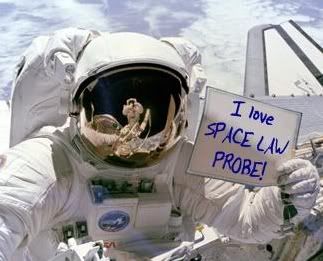12.13.2005
A Hubble Moment
 By now, orbiting blogspace, you've seen this famous Hubble mosaic of the six-light-year-wide Crab Nebula. I wanted to hang it here (alas, couldn't show the movie), as the perfect holiday decoration. SLP may be just another boring black-letter blawg, but it's also part sexy space blog, happy to use any excuse to show some cosmic color. Of course, space bloggers are not Instapundit, with their own far-flung correspondents hopping around the globe, digital cameras blazing. But space bloggers know this: Hubble, with it's uniquely placed cameras, is the personal citizen photojournalist to the planet.
By now, orbiting blogspace, you've seen this famous Hubble mosaic of the six-light-year-wide Crab Nebula. I wanted to hang it here (alas, couldn't show the movie), as the perfect holiday decoration. SLP may be just another boring black-letter blawg, but it's also part sexy space blog, happy to use any excuse to show some cosmic color. Of course, space bloggers are not Instapundit, with their own far-flung correspondents hopping around the globe, digital cameras blazing. But space bloggers know this: Hubble, with it's uniquely placed cameras, is the personal citizen photojournalist to the planet.And we sure need it. I could never capture these images with my Canon Powershot SD450 5 megapixel digital Elph with 3x optical zoom, or my Konica Minolta Dimage Z5 5 megapixel with 12x anti-shake zoom. Both of which, by the way, I recommend (I bought the Dimage first, then the Elph for something smaller) and you don't even have to know how digital cameras work to fire 'em up (although neither compare to my now destroyed but ever-classic Canon A-1, the best 35mm SLR ever produced, which died in a snow storm on the beach in 1992). These gadgets are great for shooting shuttle launches or law conferences but useless for actually photo-blogging outer space.
But we have Hubble, as long at it flies. Could NASA have made Hubble images even cooler? I asked an expert, my brother Franklin, who is a digital effects artist in Hollywood (but don't click on his IMDb listing, for some reason it's incomplete -- Frank worked with the teams that won best visual effects Academy Awards for Titanic and Spider-Man 2, he also worked on digital effects for Spiderman, which received a visual effects Oscar nomination, and Batman Begins; and his newest project, Superman Returns, opens, I think, in May).
Frank says "Hubble shots are remarkably cool, especially false colored and
composited. And being actual deep space images are much cooler than anything a digital artist can come up with (for a still!) As for animated images digital artists can create more fantastical imagery since we are not bound by any rules of reality."
By the way, one of Frank's hobbies is digital stereo photography, which involves "shooting two stereo cameras at the same time. The resultant left and right images can be combined in many ways to create a 3D depth effect when viewed." To take digital stereo shots (and secure his place as the toast of all family gatherings), Frank shoots with a custom rig consisting of two Sony Cybershot 5.1 megapixel cameras sync'd internally. It's a strange looking gadget and a bit of an attention magnet. If you've never seen a digital stereo camera (most people haven't), take a look at these models. (Don't worry, you won't need 3D glasses to view the cameras.)
Hubble can't take stereoscopic pictures. As Frank says, "the interoccular distance (between the left and right eye views) would have to be in light years."
But NASA's Mars exploration rovers do 3D. Way cool. In fact, both rovers can take stereo shots with all three cameras (pancams, navcams, hazcams). The recent trouble NASA has been having with Opportunity's stalled robotic arm impaired the space buggy's ability to take stereoscopic pictures.
But I digress. Although the Crab did not make Time's list of the best photos of 2005 (an honor reserved for pictures of tsunamis, floods, hurricanes, riots, earthquakes, famines and of course, war), deck your holiday halls with Hubble shots and other pretty pictures. Because on Earth as it is from space, image is everything.
(And wait for even more amazing things from the James Webb Space Telescope, coming -- maybe? -- in 2013...)






